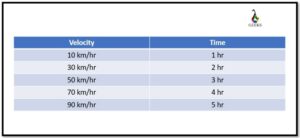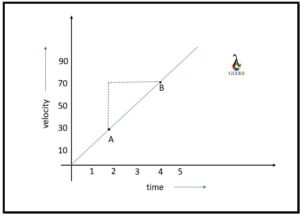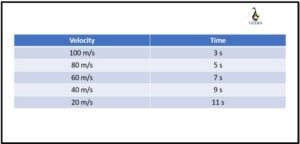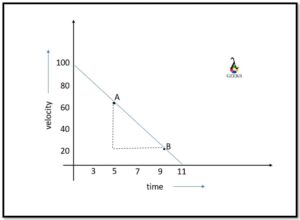Through this article, we will be comparing the positive acceleration vs negative acceleration to understand their difference.
Since velocity is a vector, therefore, acceleration is also a vector with positive and negative directions. It indicates whether the velocity is increasing or decreasing. Let us compare positive acceleration vs negative acceleration.
With an increase or decrease in the velocity of a moving body, acceleration emerges. By calculating the rate of change of velocity the value that we get is simply the acceleration of a moving body. The general way of finding acceleration is given as:
a = v2-v1/t2-t1
or a = dv/dt
Here,
a is the acceleration
v2 is the final velocity
v1 is the initial velocity
t2 and t1 are the respective periods.
The unit of velocity is ms-1. Therefore the unit acceleration would be ms-2.
To understand acceleration let us take an example. Suppose a man is driving a car at a speed of 60 km hr-1 after going to some distance the road becomes clear so he increases his speed to 80 km hr-1 which means he has accelerated the car.
Now the acceleration can be both negative and positive as we have already told. For the formula a = v2-v1/t2-t1, in case of positive acceleration we will have v2>v1. Which will mean that the final velocity is greater than the initial velocity and speed increasing.
Now for the same formula for negative acceleration, we will have v1>v2 which will mean that the initial velocity is greater than the final velocity. Hence the velocity of the moving body is decreasing with time, this is also known as deceleration.
Let take a look at the example we have taken before. The man accelerated his car from 60 km hr-1 velocity to 60 km hr-1 It is an example of positive acceleration in which the final velocity exceeds the initial velocity. Now suppose, after going some distance the man finds traffic and thus has to decrease the velocity of the car from 60 km hr-1 to 50 km hr-1 . This example is of negative acceleration as in this case the velocity has reduced.

Hope this example makes you understand positive acceleration vs negative acceleration. Let us see the graphs of positive and negative acceleration to understand it in detail. By calculating the slope of the velocity-time graph we get the value of acceleration.
For the above table, we plot the velocity-time graph. The graph will provide us with the acceleration of the body.

The graph is drawn as shown above. We can see that the slope is moving upwards therefore it is a positive acceleration. Now to calculate the acceleration we take any two points and then find out the slope (acceleration):
a = y2-y1/x2-x1
a = 70 – 30/4 – 2
a = 40/2
a = 20
Therefore we can see that the acceleration is positive.

In the table above we are given the velocities of rolling balls on the ground. Let us plot the graph by taking velocity on the y-axis and time on the x-axis.

After plotting the points we join them and get the slope as shown above. On moving from left to right of the graph we find the slope is moving downwards which indicates that the body is decelerating. Therefore the negative acceleration has the slope moving downwards. Let us calculate the acceleration:
a = y2-y1 / x2-x1
a = 25 – 65/9 – 5
a = -40/4
a = -10 m s-2
Therefore we can see that the acceleration is negative.
Now, apart from positive and negative acceleration, we can have the acceleration to be zero. In this case, it does not mean that the body is not moving. The concept of zero acceleration only means that the body is not accelerating at all and is moving with constant velocity. Let’s represent it mathematically:
a = v2-v1/t2-t1
Since velocity is not changing let v2 = v1 = v, substituting it in the above equation we have:
a = v-v/t2-t1
a = 0
The graph of constant velocity or zero acceleration is a straight line. It indicates that the velocity of a moving body remains the same for different time intervals.

The above graph shows both positive, negative and zero acceleration. Slope from A to B in the region of positive acceleration. Slope from B to C is the region of zero acceleration and slope from C to D is the region of negative acceleration.
So that was all about the positive acceleration vs negative acceleration. We have explained them with examples and with graphs also. In case of any further doubts read the questions given below.
Frequently Asked Question (FAQs)
Explain positive acceleration vs negative acceleration.
Acceleration can have values positive as well as negative.
When the velocity of a moving body keeps increasing over time then the body is said to accelerate positively. Whereas when the velocity decreases with time it has a negative value.
Is retardation the same as deceleration?
Retardation means the rate of decreasing velocity.
Retardation is the same thing as deceleration both means a decrease in velocity over a given time. They both are also known as negative acceleration.
Can acceleration be zero?
Acceleration can have all the values from negative, positive to zero.
The zero acceleration means that the body is moving with constant velocity. The final velocity and initial velocity both remain the same and therefore we get acceleration as zero.
How to calculate acceleration?
Acceleration is the rate at which the moving body changes its velocity.
From the definition of acceleration, we get its formula as:
a = Δv/Δt
a = v2-v1/t2-t1
Here, v2 and v1 are the final and initial velocities. t1 and t2 are the respective time intervals. The unit of acceleration is ms-2
Also Read:
- How to find acceleration with kinetic friction
- Constant acceleration examples
- How to find acceleration in free fall
- How to find acceleration down a ramp
- How do you find acceleration with speed and time
- How to find acceleration calculus
- How to find acceleration vector
- Instantaneous acceleration formula
- How to find constant angular acceleration
- How to find acceleration with angle and coefficient of kinetic friction
Hi,
I am Rabiya Khalid, I have completed my masters in Mathematics. Article writing is my passion and I have been professionally writing for more than a year now. Being a science student, I have a knack for reading and writing about science and everything related to it.
In my free time, I let out my creative side on a canvas.